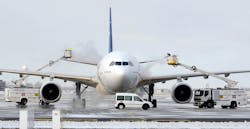Poland’s Ground Handling Competition
Poland is a country in Eastern Europe which is experiencing a healthy economic growth. Its aviation industry is also flourishing, and in such a context of expansion the aircraft ground handling industry is exposed to a very distinctive operational reality.
Whereas, in many parts of the world, wages have more or less stagnated over the last several years, the economic boon in Poland is causing a wage pressure which is making it increasingly difficult to recruit line operatives and pushing down aircraft ground handling margins and yields.
A Sophisticated Infrastructure
The aircraft ground handling infrastructure in Poland is sophisticated enough to cater to the increasing traffic volumes being experienced at airports across Poland.
According to Pawel Zagrajek, head of board and strategy department at Welcome Airport Services, a leading provider of ground handling services at six airports throughout Poland, the matter of increasing traffic volumes only partially affects aircraft ground handling providers.
“However, individual ground service providers play an important role in the functioning and use of airport infrastructure. We constantly modify our resources to fulfil the air carriers’ needs, which sometimes is difficult, but manageable,” he says.
“Regardless of the market situation and the rate of traffic growth, our company is actively committed to placing safety and quality as top priorities. This has been proven several times, including the prizes for best stations awarded by our customers,” Zagrajek continues. “We are ISAGO registered, and we decided to extend the registration under the new recently introduced conditions which envisage changes to how the ISAGO registration system is financed. As a consequence we constantly adapt our equipment to the needs and requirements of the market. For this reason, we do not expect the ground handling infrastructure to be an obstacle to future market development.”
Distinctive Challenges
In many ways, Polish ground service providers are facing operating challenges which are common to their counterparts all over Europe, such as high personnel turnover rates, different operational standards to follow and low margins.
However, aircraft ground handling companies operating in Poland also have some distinctive operational challenges.
“Firstly, the dynamic traffic growth is putting pressure on capacity at some Polish airports. Traffic is often concentrated in peaks and it makes effective resource management even more complicated. This is sometimes accompanied by lack of space for ground handlers in terms of social space and ground support equipment (GSE) parking,” says Zagrajek.
“Moreover, the labor market is posing other challenges to ground service providers,” he says. “There is a shortage of employees - mainly for ramp services – and this is forcing ground handlers to put a lot of effort into recruitment and training. This is also a reason of recent salary increases in the ground handling industry. At the same time, we are facing constant pressure from airlines on prices and turnaround times as well as constantly evolving product ranges. As we do not compromise on quality and safety, these opposing forces are squeezing our margins in the market to very low levels.
“As an overall assessment we can say that the Polish ground handling market is characterized by low yields and low margins.”
An Upgrading GSE Fleet
The GSE fleet of ground handlers in Poland is increasing in terms of sophistication, and GSE is increasingly embedding new technology features.
“Our GSE fleet is tailored to the needs of our customers. Our long term policy is to provide for the replacement of used equipment by new pieces of equipment featuring modern technology, including electrically powered GSE,” says Zagrajek. “In a competitive environment like Poland the technological sophistication of equipment can be an element of differentiation. We are increasingly looking at electrically powered GSE also with the aim of reducing our carbon footprint. We have also recently unveiled a new solution for managing the flow of passengers with reduced mobility (PRM). The new solution entails a simplification of the whole process and we are one of the leaders thanks to our approach to PRM assistance, which is one of the ground services we provide.”
Competitive Forces
The competitive scenario of the aircraft ground handling business in Poland is characterized by a wide variety of players.
Currently, there are nearly 50 companies holding a ground-handling license, permitting them to operate in the Polish market.
“However, the activity of the majority of the providers is limited in scope, and in the main ground handling categories, the services are rendered only by a lower number of companies with two distinctive leaders, Welcome Airport Services being among them. Regardless of the limited number of sizeable market players, a tough competition takes place in the market. This results in low yields and consequently low margins,” says Zagrajek.
In this competitive environment, ground handling companies are exposed to opposing forces: the costs pressure, mainly from labor, and the price pressure from airlines.
“One should remember that ground handling services rely extensively on manpower, as labor accounts for at least 60 percent of the costs. Currently in Poland there is a fierce competition in the labor market. This results in growing wage pressure,” says Zagrajek. “The majority of the positions we offer are basic positions. When we are recruiting people, we are in competition not only with other ground handlers but also with the likes of factories and warehouses, which also offer basic positions.
“This issue is accompanied by constant price pressure from airlines and their high expectations on quality of service and performance,” he adds. “The threat is that the level of charges negotiated today may not be sufficient to break even in the next year due to the change of the average level of salaries in the country.”
About the Author

Mario Pierobon
Dr. Mario Pierobon provides solutions in the areas of documentation, training and consulting to organizations operating in safety-sensitive industries. He has conducted a doctoral research project investigating aircraft ground handling safety. He may be reached at [email protected].
